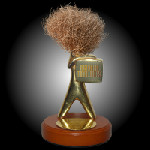Face Up Comes Kennedy
If you were born after the last episode of The Graham Kennedy Show went to air (1975) it’s sometimes hard to understand Graham Kennedy’s legendary status in Australian television. Even now little of the tonight show work on which his legend is built is easily available. Umbrella’s recent DVD release of four episodes of The Graham Kennedy Show does sort of explain it, but unless you were around at the time there’s a lot you aren’t going to get from the shows themselves.
The first episode on this DVD set comes from 1960. With Kennedy’s In Melbourne Tonight hugely popular in Melbourne after several years on air, The Graham Kennedy Show was launched to try and make Kennedy a national celebrity. Wikipedia gives full details of the production history and critical reaction to the show, and it’s hard not to agree that “Kennedy seemed much more subdued than usual, was tense, and the comedy was not working” based on this one episode. Small sparks of the future King of Television are visible (particularly in anarchic way he diverts from the script in the live ads) and there’s an eclectic mix of guests (Japanese pop legend Peggy Hayama performs several of her hits on a specially constructed set of paper screens!), but overall the show’s more interesting than good.
The next two episodes come from 1972 or 1973 (no exact dates are given), and these include appearances from Bert Newton, Pete Smith, Joff Ellen, Lorrae Desmond, John English, Ozzie Ostrich and Joy “Mrs Barry from Prisoner” Westmore. The first of these two episodes was the first to be broadcast in an AO (Adults Only) timeslot, and Kennedy, cast and writers seem to relish the opportunity to have some adult fun. They’re helped along by the fact that there was some controversy in the news at that time about the Statue of David (although why a sculpture which was 470 years old was the subject of controversy at that time is unclear) and the show opens with Kennedy surrounded by miniatures of the art treasure, about which he makes almost every conceivable gag.
Towards the end of the show is the inevitable wheel segment, with Bert Newton assisting. As on The Don Lane Show the wheel segment is part hilarious/part endless, with minutes of air time filled by in-jokey back and forths between Gra-Gra and Bert over the head of the bemused contestant. There are also, still, a fair number of live ads, including one with Bert spruiking Kentucky Fried Chicken dressed as Colonel Sanders. Amongst Bert’s dialogue is the line “I like the boy”, which suggests that this later-to-become-infamous phrase was something Bert busted out a lot back then.
The second of the early 1970s episodes, and the final one in black and white, ends with an appearance from Ozzie Ostrich who, after a long and rather dull exchange with Graham, reads a mercifully short (but bad) poem. Based on this it seems that what the character of Ozzie really needed was a maniacal egotist to keep him in check, and helpfully the very man appears in the final episode in this set, made in 1975…
23-year old children’s TV host Daryl Somers, resplendent in mid-70s mullet and open-neck shirt, is the first act on the show, and he delivers a song in that deep, off-key voice of his while two backing dancers do their thing around him. Daryl then joins Graham at the desk and is told that he is the man Graham hopes will replace him. The young Daryl turns out to be shy and modest in the presence of Kennedy, almost charming in fact, but clearly the damage is done. Thus anointed by The King, Prince Daryl went on to conquer the world.
And if you think that’s the only thing significant about that episode then you clearly weren’t watching the bit before Daryl came on… The episode really started with Kennedy delivering a rant against Senator Doug McClelland, the then Minister for the Media. Hot on the heels of the famous “Crow Call” incident, Kennedy uses this as an opportunity to argue that while he’s being censored for saying something which sound like “fuck”, the government are failing to protect the local industry from cheap imports. This is a fantastic, fiery piece of television, and one which was notoriously censored at the time. It’s great that it still exists and has made it to this boxset. And actually, despite the fact that us young folk with our iPhones are going to miss a lot of the context of these shows, it’s just great to see them. We don’t have to get the references and we don’t have to like every second of them because they’re interesting enough to be worth watching – and it’d be great to see more of them released.
